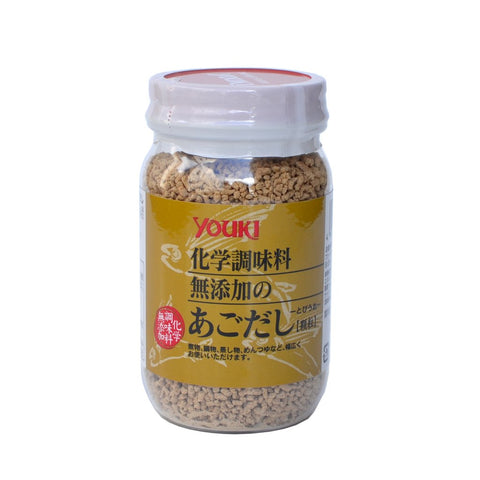
Sake Gumi is our monthly sake subscription service with 150 members throughout California. Join today!
Back in 2006, Kayoko had an idea to start a food blog. During Christmas break, we were both back in our hometown, Cupertino – Kayoko was living in New York while I was living in Tokyo. We had so much to talk about in terms of the foods and drinks we were consuming in two really great food cities.
Kayoko decided to call the blog Umami Mart. As Japanese-Americans, we'll usually just say that umami or umai means delicious. So if a green tea tasted good or a toro-maki was especially exquisite, I'd say "mmm, so much umami!" But… what is umami exactly?
In 1985, the term umami was recognized as the scientific term to describe the taste of glutamates (a type of amino acid) and nucleotides. Foods high in glutamates and nucleotides are dashi, tomatoes, green tea, cheese, sardines, and sake (duh!). Some words to describe umami are: brothy, meaty, and savory.
It's no wonder that the first posts that Kayoko and I blogged were about foods rich in umami. For example, Kayoko's (Feb. 28, 2007 post) titled, "Green Tea Frenzy" was about Trader Joe's Green Tea Yogurt, while mine was about buying shimesaba (marinated mackerel) and salmon sashimi from the grocery store.
Several factors can affect the amount of umami in a sake. Junmai sakes tend to have higher umami than honjozo sakes (which have added brewers alcohol). Hence, all of the sakes for this month are junmais. However, different brewers bring out umami in different ways. Some sakes this month are keeping the junmai character while expressing ginjo characteristics in the nose, while others are using lots of koji or aging the sake. Read on to find out how each one expresses umami in their sake.
Umami Mart has taken us across continents and has spanned across two decades – this year we celebrate six years of our brick and mortar shop. When I asked Kayoko, "How did you come up with the name, Umami Mart?" She replied "It just sounded good, plus I wanted to create a market of ideas about food and drink." Sounds pretty delicious to me!
Kanpai,
Yoko
LEVEL 1: Introductory Membership (Two 300ml bottles)
 Umami Sonomama 10.5
Umami Sonomama 10.5
Sawanotsuru Brewery (Hyogo, Japan)
Seimaibuai: Yamada Nishiki 75%, SMV: -10
The brewers at Sawanotsuru set out to create a low-alcohol sake that retains umami. To acheive this, they’ve used two times the usual amount of koji in the brewing process. This results in an aroma full of mushrooms, but also the prominence of lactic acid. They call this sake their “weekday” sake, a sake that is so low in alcohol (10.5% abv) that you can enjoy it during the week. I loved this sake with chawanmushi (a Japanese savory egg custard dish). Have this tart and umamiful sake with other egg dishes like omelettes, tamago or Nicoise Salad. Best chilled at 50°F.
 Kiku-Masamune Koujo Junmai
Kiku-Masamune Koujo Junmai
Kiku-Masamune Brewery (Hyogo, Japan)
Seimaibuai: 70%, SMV: -2
The concept behind Kiku-Masamune’s Koujo Junmai was to create a junmai in ginjo’s clothing. Released just last year in the U.S., the brewer wanted to create a sake that has the aroma of ginjo (apples and pears) while retaining the umami of junmai. So how did they do it? They used an in-house yeast called Kikumasamune HA14, a yeast that highlights fruity ginjo aromas without having to mill the rice to ginjo standards (60%). The advantage to this is that you get a delicate smelling sake that pairs well with food. We enjoyed this sake alongside, lotus root tempura. Koujo is brewed using the brewer's newly invented original yeast, Kikumasa HA14. Recommended at room temperature.
LEVEL 2: Premium Membership (Two 720ml bottles)
 Born Muroka Nama Genshu Junmai Daiginjo
Born Muroka Nama Genshu Junmai Daiginjo
Kato Kichibee Shoten Brewery (Fukui, Japan)
Seimaibuai: Yamada Nishiki 50%, SMV: +4
The brewery calls this sake an uma-kuchi sake. Uma or umai (derived from the word umami) means delicious – and the use of it is very subjective. People most commonly use umai when they are describing flavors that are layered, meaty, or bold. Although the aroma of this sake is full of nectarines and plums (the daiginjo at work), the viscosity and sweetness mimics a thick brothiness (the nama genshu). This sake is also aged for one year to acheive a silky, smooth flavor. I was lucky enough to have this with a sashimi at Sushi Kuni including hamachi, ika, saba, tuna and salmon. I highly recommend taking this to your next sushi meal! Have chilled or on the rocks with a twist of lime.
 Kinoene Junmai Migaki 8-wari
Kinoene Junmai Migaki 8-wari
Iinuma Honke Kinoene Masamune Brewery (Chiba, Japan)
Seimaibuai: Fusakogane 80%, SMV: +2
To highlight umami in this junmai, the brewers only polished the rice 20%. In addition, this sake is aged for one year to acheive a depth that reminds me of a natural wine. Mushroom and caramel collide in the aroma which is complemented with a grape-like flavor and a clean ending that is reminiscent of a dry Saperavi red wine from the Replublic of Georgia. Enjoy this sake at room temperature or slightly warm at around 100°F with meaty bites like duck, pork, and shiitake mushrooms. It was a perfect pairing alongside pork gyoza!




Comments (0)
There are no comments for this article. Be the first one to leave a message!